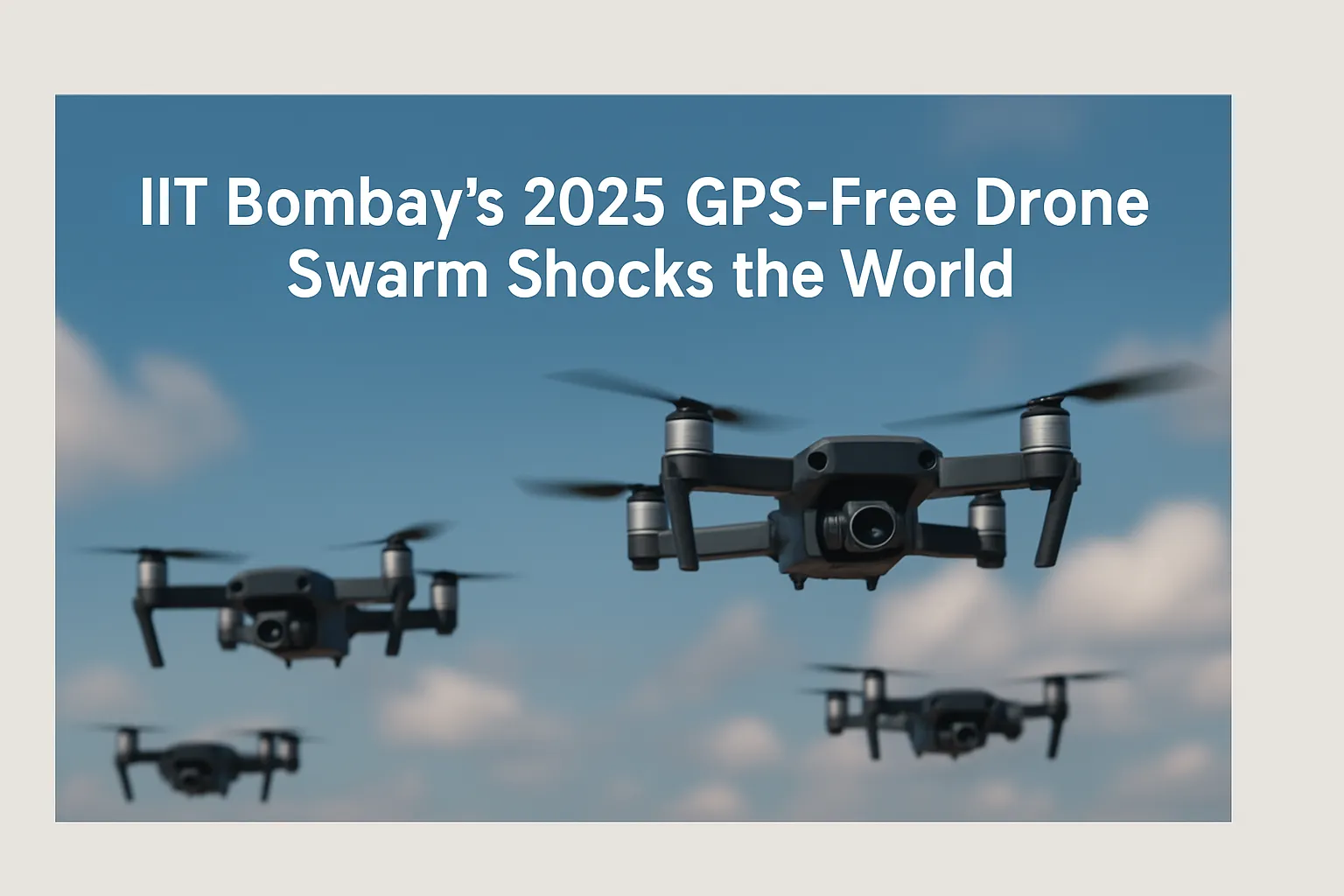When I first heard about a GPS-free drone swarm, it felt like science fiction. How could drones coordinate without GPS, communication links, or a control tower? Yet, IIT Bombay proved it possible. Their autonomous UAV system lets drones see, decide, and fly together using only onboard vision.
This IIT Bombay drone research could transform how nations defend borders, carry out rescue missions, and explore dangerous zones. The future of GPS-free swarm drone technology has begun, and it is faster, smarter, and fully independent.
The Vision Behind IIT Bombay’s Innovation
The goal was simple but bold: design GPS-denied environment drones that could work anywhere.
Professor Dwaipayan Mukherjee and scholar Chinmay Garanayak led this mission at IIT Bombay’s Electrical Engineering Department. Their IIT Bombay-developed GPS-free drone swarm is the result of years of testing, modelling, and simulation.
The project, supported by the ANRF Grant CRG/2023/002280, proves that vision-based coordination can replace both GPS and communication systems in the toughest conditions.
How the GPS-Free Swarm Drone Works
Each drone in the IIT Bombay GPS-free drone network uses a camera to detect nearby drones. It measures two key factors:
- Bearing the direction of a neighbour, and
- Bearing rate, how fast that direction changes.
With just these inputs, each drone adjusts its motion to maintain or change formation.
- In stable missions, it tracks bearing and bearing rate.
- In moving formations, it also uses its own velocity.
No drone depends on a leader; the system is fully decentralised and self-reliant.
Why GPS-Free Swarms Matter
GPS signals can be jammed or lost in battlefields, dense cities, or natural disasters. A GPS-free drone swarm ensures continuous operation.
Core advantages:
- Stealth: No radio transmission means lower detection.
- Reliability: Functions in GPS-denied zones.
- Autonomy: Every drone makes local decisions.
- Flexibility: Works indoors, in forests, or in mountainous terrain.
Such systems redefine how GPS-denied environment drones perform missions where communication and navigation are compromised.
Defence and Security Applications
For defence forces, this GPS-free drone swarm developed by IIT Bombay is a strategic breakthrough.
- Border surveillance with zero communication links.
- Electronic warfare missions in signal-jammed zones.
- Autonomous reconnaissance with minimal risk to soldiers.
- Coordinated strikes or supply drops in high-risk areas.
The IIT Bombay GPS-free drone system positions India at the forefront of autonomous UAV technology and enhances national defence capability.
Civil and Humanitarian Uses
Beyond combat, this technology is equally valuable for civil use.
- Search and rescue after earthquakes or floods, where networks fail.
- Disaster mapping to locate survivors or damage zones.
- Environmental tracking of forest fires, oil spills, or pollution.
- Industrial inspection of large plants or mines.
These GPS-free swarm drones make missions faster, safer, and more reliable.
The Science Behind IIT Bombay Drone Research
Most earlier systems worked only on simplified models. The IIT Bombay drone research team went further, using the full underactuated VTOL dynamic model that includes lift, thrust, torque, and attitude.
They mathematically proved that formations stay stable even when drones start from random positions.
This makes the algorithm practical for real-world UAV deployment, not just lab simulations.
Future Plans and Challenges
The next step is real-world testing with multiple VTOL drones. The team aims to improve:
- Collision avoidance using computer vision.
- Low-light performance with thermal sensors.
- Scalability for hundreds of drones.
- AI integration for adaptive navigation and obstacle prediction.
Once complete, these upgrades will make IIT Bombay’s GPS-free drones ready for defence and rescue missions across India.
India’s Strategic Edge
This work supports India’s vision of Atmanirbhar Bharat in advanced defence technology.
Home-grown GPS-free swarm drones can patrol borders, monitor coastlines, and secure airspace without foreign systems.
It empowers the Army, Navy, and Air Force to carry out long-range autonomous operations.
The IIT Bombay developed a GPS-free drone swarm that showcases India’s ability to innovate and lead in global drone autonomy.
Also Read: Inside India’s Shield AI V-BAT UAS Drone Deal
Explained: Inside India’s New Low-Cost Anti-Drone Missiles
Global Perspective
Countries like the USA, China, and Israel are exploring drone swarms. Most rely heavily on GPS or cloud communication.
The IIT Bombay GPS-free drone approach stands out for its simplicity and cost efficiency.
It shows how visual sensing and control theory can achieve advanced coordination without expensive satellite links.
Benefits in Brief
- No GPS or radio needed
- Decentralised and fail-safe
- Low cost and light hardware
- Proven mathematical stability
- Works in GPS-denied environments
- Ready for defence, rescue, and research use
Conclusion
The GPS-free drone swarm created by IIT Bombay is a milestone in modern aviation.
By allowing drones to navigate through vision alone, it eliminates reliance on satellites and fragile networks.
It will strengthen national security, improve disaster response, and inspire global research.
With this achievement, IIT Bombay’s drone research has opened a new chapter in autonomous UAV innovation, proving that the sky no longer needs a signal to stay connected.
